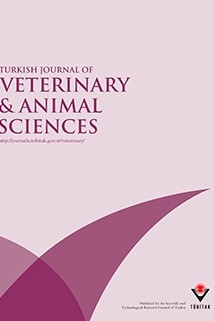
Turkish Journal of Veterinary and Animal Sciences
Yazarlar: Ayhan BAŞTAN
Konular:-
Anahtar Kelimeler:Bitch,Endometrial cytology,Sexual cycle,Pregnancy,Pyometra
Özet: The purpose of this study was to investigate cellular changes of the uterus during pregnancy, pyometra and different phases of the sexual cycle in dogs using endometrial cytology. We used 30 uteruses from bitches of different ages and breeds and at heterogeneous stages of the sexual cycle (Group 1 proestrus n = 5, Group 2 estrus n = 5, Group 3 diestrus n = 5, and Group 4 anestrus n = 5) as well as animals with open cervix pyometra (Group 5 n = 5), and that were pregnant (Group 6 n = 5). The sexual cycle stage of the bitches was identified by vaginal cytology prior to ovariohysterectomy. The groups were selected from a large number of samples following vaginal cytology and ultrasonographic scanning. Blood samples (10 ml) were collected from the bitches by puncturing the v. cephalica antebrachi before surgery. The endometrium was revealed by longitudinal dissection of uterine horns after laparotomy. Uterine wall swabs were obtained from the mid part of one horn by rotating the cotton swabs on the endometrial surface. Cotton swabs were smeared over microscopic slides and the samples were dyed using the Papanicolau technique. The neutrophils, erythrocytes, bacteria and endometrial epithelial cells were evaluated for endometrial cytology. Cell scores were given that ranged from 1 to 4 according to frequency. In this study, variations in the type and density of cells according to stages of the sexual cycle, as well as pregnacy and pyometra cases, were observed. In the proestrus stage, an excessive number of erythrocytes, and a few neutrophils, endometrial epithelial cells and bacteria were found. In the estrus stage, a few neutrophils and erythrocytes and a moderate density of bacteria were observed, while in the diestrus stage, a few endometrial epithelial cells and neutrophils were noted. In the anestrus stage, a moderate density of degenerated endometrial epithelial cells, neutrophils and bacteria were observed. During pregnancy, a few epithelial cells and neutrophils were found. In pyometra cases, dense bacteria degenerated epithelial cells and neutrophils were identified. The number of neutrophils was lower in the progesterone dominated phase than in the estrus stage. In conclusion, endometrial cytology can be used to determine physiological and pathological changes in the endometrium and that when transcervical cannulation techniques are fully developed they will constitute a practical, cheap and reliable diagnostic tool to identify uterine disorders.